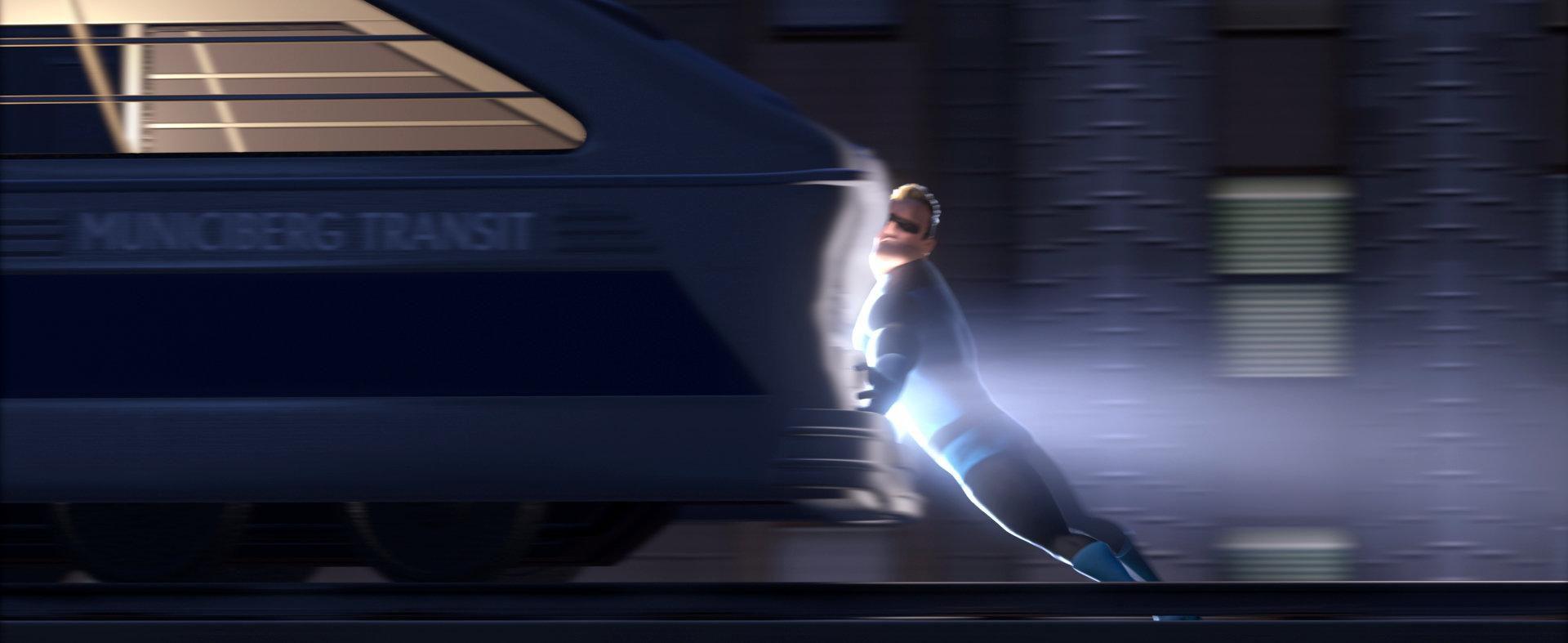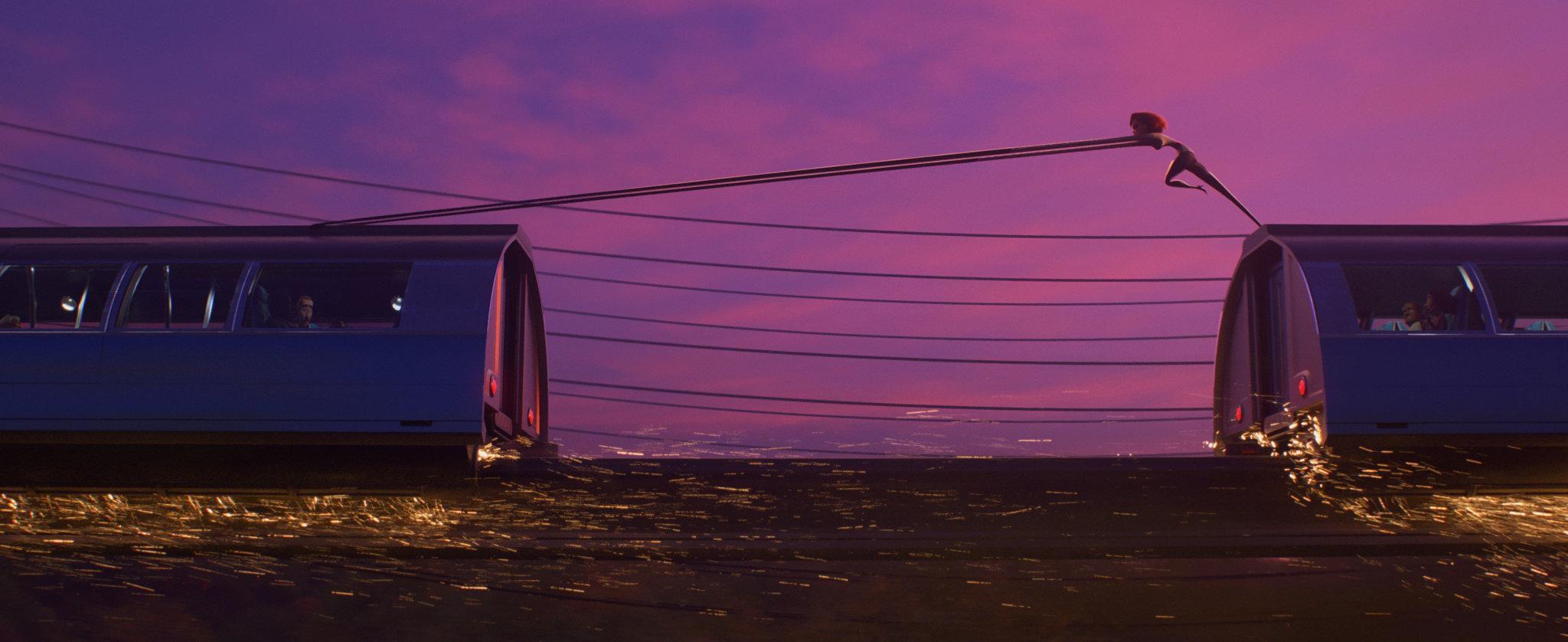It takes a lot to laugh, but it takes a train to cry. The Incredibles hinges on a high-speed train that narrowly avoids derailing and unravels the movie’s plot. Call it a runaway MacGuffin. The scene—an action set piece of uncommon verve and wit—sets up the motivations of the 2004 movie’s big villain, reveals Mr. Incredible’s hubristic approach to crime fighting, and underscores the stakes of Pixar’s first story starring (super)human characters. It’s a key moment in a complicated movie. And for its sequel, which arrives 14 years after the original, writer-director Brad Bird knew he had to one-up it.
“We’re always looking for ways to simplify things and certain rules that help us to whittle away the inessential,” Bird tells me. “And one of the rules that I gave the crew in the first Incredibles, which we also have in this one, is you don’t do something fantastic very long without doing something mundane. And you don’t do something mundane very long without doing something fantastic.”
It’s a mantra with practical application. Bird cited a scene in the original film in which Elastigirl attempts to infiltrate a villain’s high-tech lair and catches a glimpse of her figure in a shiny surface. “Oh wow,” shes says to herself, “I’ve got to do something about that.”
“There’s this very mundane human moment in the middle of this fantastic world,” Bird says. “And that’s a wheelhouse that we like to explore.”


In Incredibles 2, Bird goes back to the train station, only this time Elastigirl is the hero and the train is of the high-speed bullet variety. Once again, it introduces our villain (the masked, hypnosis-wielding Screenslaver), spotlights Helen Parr’s power in the story, and ups those pesky stakes. It is somehow a redux and a reinvention at the same time. It’s thrilling. Commensurate with the rules of expansion that all sequels must abide by, Incredibles 2 is bigger and bolder than its predecessor, but what makes it such a major and useful sequel is the way it completely redefines what it means to make an action movie.
For nearly 100 years, the balance of power in action movies was evident: The real thing is the real thing. Practical effects had a tactile power that animated movies never could. But as more and more superhero and action franchises turn so aggressively to the green-screen-aided pre-visualization strategy of moviemaking—affirming the CGI Generation—action on a grand scale has become homogeneous. The fight scenes are mediocre and incoherent. The violence is ludicrous and self-referential. And the grand-scale set pieces are cartoonish to the point of parody. So who better to blow it up than an animated movie?
“I was lucky enough to work with some old Disney masters as a kid,” Bird, who is 60, says. “And they got into my head that they were eternally students. When they were at the height of their powers and these guys were in their 60s and they were the best in the world, they still acted like they had a lot to learn. And that made a huge impression on me.”
Bird, who also made Pixar’s iconic Ratatouille, as well as the live-action Mission: Impossible–Ghost Protocol, has an uncommon knack for following characters in space. He had some notable inspiration.
“I feel like I’m a student and hopefully will be until the end of my days because there’s always something you can learn,” he says. “And my heroes in terms of action staging are Spielberg and James Cameron and George Miller and a few films of John McTiernan—Die Hard, I think is just an amazing action movie. And one of the things they have in common is that they are super-aware of geography, of where everything is in relation to everything else and they’re constantly updating the audience in a way that’s artistic and full of flair but they’re constantly updating, now this person’s near the window, now this is happening. And they can do it at lightning speed. It’s actually really hard to be both clear and fast. And a lot of people can’t do it.”
The breakneck pace of production for franchise films and the ever-growing demand for new features has placed a major burden on filmmakers. At Pixar, the meticulous and often endless-seeming production period—Incredibles 2 has been more than four years in the offing—gives these films an uncommon advantage: time. Even when it doesn’t feel that way for the filmmakers.
“I’m always looking to speed it up,” Bird says. “There are people, Chris Nolan [for example] manages to do really big, ambitious films but on a fairly brisk clip for how complicated the films are. So I would love to pick up the pace. But they took a year off the production of [Incredibles 2] because we got moved up because Toy Story 4 was having story complications. And that’s not unusual for Pixar. Incredibles was supposed to be after Cars and we came together a little more quickly than the story reels for Cars. So that’s a normal thing. But we did move a little faster and yet in some way or another it’s three years later.”
Sometimes that comes from a finely honed script that carefully plots the action beats, which Bird slaves over. And sometimes the story geniuses at Pixar convene to invent the best scene.
“If we’re to use the first Incredibles as an example, there are some scenes that I wrote incredibly specifically where I write every action beat and that was like the sequence we called ‘the 100-mile dash,’ which is where Dash is running through the jungle,” Bird says.
“I had every beat of that written in the screenplay. And then the end sequence where the robot [stomps] through the city was the opposite. I had the key story beats that we needed to see, Bob needs to save the kids from getting crushed, Frozone needs to enter the scene here. I had those general beats. But I turned it over to [story consultant] Mark Andrews and the story crew and said, ‘We need to get together and just throw ideas around, and here’s the overall shape but all the specifics are up for grabs.’ And people would just rain down ideas and then you kind of grab them and throw your own in and kind of sculpt it.”
In Incredibles 2, Bird went a step further. With a growing cast of heroes and the limitations that the story’s villain creates, he brought the real world into his animation.
“There’s a fight between Helen and the Screenslaver in this movie that was really difficult to do,” he says. “And we even brought in a stunt guy, a coordinator and designer that I worked with on Mission: Impossible–Ghost Protocol and Tomorrowland named Rob Alonzo, who loves and has studied animation. But he’s also a really good fight choreographer. And he came in and talked to our animators and our storyboard artists like, ‘This is what someone would do if they had to fight blind.’ And they would try to find a corner so that they can limit the areas that they’re being attacked from.”
Bird cites the vastly more sophisticated animation power and speed at Pixar, particularly the development of “fast rough renders” that indicate how to physically map out a scene when it’s been plotted. The lighting, too, once a slow process for animation—and one most filmgoers never even consider—has now become considerably easier to execute. “So you can hone the visuals in a way that you couldn’t in those [early] days,” Bird says. “And the rigs, which are the character puppets that the animators use, are way more responsive and intricate. And you have better controls.”
“So for the animators it’s like there are these amazing drivers and we have much better cars for them now to go,” he says. “But they still need drivers. A car is useless without a driver.”
A train, too.
